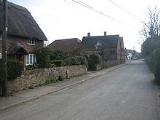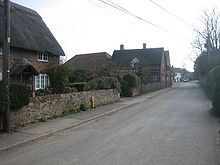
South Stoke, Oxfordshire
Encyclopedia
South Stoke is a village and civil parish on the River Thames
, about 1.5 miles (2.4 km) north of Goring-on-Thames
in South Oxfordshire
.
The parish includes the hamlet and manor house
of Littlestoke
, 1 miles (1.6 km) north of the village.
 In AD 975 King Edgar
In AD 975 King Edgar
granted Osweard land at Stoke, probably later the South Stoke and Offham manors.
The manor passed to Eynsham Abbey
in 1094. At the time of the Hundred Rolls
in 1279, South Stoke had 40 tenants and only three freeholders. Woodcote
, 3 miles (5 km) east of South Stoke, had developed as a dependent settlement by 1109. It was followed by Exlade Street
by 1241 and Greenmoor by 1366.
of Saint Andrew
was built in the 13th century and still has Early English Gothic features including the three-bay
arcade
between the nave
and the north aisles, windows in the north wall of the chancel
and the east and west ends of the south and north aisle. The east window of the south aisle has late 13th century stained glass of the Virgin and Child
.
In the 14th century the present font
was carved, a new chancel arch was built and new windows were inserted in the east and south walls of the chancel and the north and south walls of the nave
. The west tower is a Perpendicular Gothic addition. In 1857 the church was restored, the south arcade was rebuilt and south aisle was widened. The architect for these works was J.B. Clacy
of Reading
.
The Vicarage was designed by the Gothic Revival architect
Charles Buckeridge
and built in 1869.
In 1820 a chapel
was built for the Countess of Huntingdon's Connexion
. It is now a private house.
built Moulsford Railway Bridge
in 1839-40.
South Stoke has a public house
, the Perch and Pike.
The Ridgeway
path runs through the village.
River Thames
The River Thames flows through southern England. It is the longest river entirely in England and the second longest in the United Kingdom. While it is best known because its lower reaches flow through central London, the river flows alongside several other towns and cities, including Oxford,...
, about 1.5 miles (2.4 km) north of Goring-on-Thames
Goring-On-Thames
Goring-on-Thames is a large village and civil parish on the River Thames in South Oxfordshire, about south of Wallingford.-Geography:...
in South Oxfordshire
South Oxfordshire
South Oxfordshire is a local government district in Oxfordshire, England. Its council is based in Crowmarsh Gifford, just outside Wallingford....
.
The parish includes the hamlet and manor house
Manor house
A manor house is a country house that historically formed the administrative centre of a manor, the lowest unit of territorial organisation in the feudal system in Europe. The term is applied to country houses that belonged to the gentry and other grand stately homes...
of Littlestoke
Littlestoke
Littlestoke is a hamlet on the River Thames in the civil parish of South Stoke in South Oxfordshire, north of Goring-on-Thames.Littlestoke is on the old road that linked Wallingford and Reading via Goring Heath.Littlestoke has a manor house....
, 1 miles (1.6 km) north of the village.
Manor

Edgar of England
Edgar the Peaceful, or Edgar I , also called the Peaceable, was a king of England . Edgar was the younger son of Edmund I of England.-Accession:...
granted Osweard land at Stoke, probably later the South Stoke and Offham manors.
The manor passed to Eynsham Abbey
Eynsham Abbey
Eynsham Abbey was a Benedictine monastery in Eynsham, Oxfordshire, in England between 1005 and 1538. King Æthelred allowed Æthelmær the Stout to found the abbey in 1005. There is some evidence that the abbey was built on the site of an earlier minster, probably founded in the 7th or 8th...
in 1094. At the time of the Hundred Rolls
Hundred Rolls
The Hundred Rolls are a census of England and parts of what is now Wales taken in the late thirteenth century. Often considered an attempt to produce a second Domesday Book, they are named for the hundreds by which most returns were recorded....
in 1279, South Stoke had 40 tenants and only three freeholders. Woodcote
Woodcote
Woodcote is a village in the civil parish in South Oxfordshire, about southeast of Wallingford and about northwest of Reading, Berkshire. It is in the Chiltern Hills, and the highest part of the village is above sea level....
, 3 miles (5 km) east of South Stoke, had developed as a dependent settlement by 1109. It was followed by Exlade Street
Exlade Street
Exlade Street is a hamlet in Checkendon civil parish in Oxfordshire about northwest of Reading. The hamlet is about above sea level in the Chiltern Hills....
by 1241 and Greenmoor by 1366.
Churches
The Church of England parish churchChurch of England parish church
A parish church in the Church of England is the church which acts as the religious centre for the people within the smallest and most basic Church of England administrative region, known as a parish.-Parishes in England:...
of Saint Andrew
Saint Andrew
Saint Andrew , called in the Orthodox tradition Prōtoklētos, or the First-called, is a Christian Apostle and the brother of Saint Peter. The name "Andrew" , like other Greek names, appears to have been common among the Jews from the 3rd or 2nd century BC. No Hebrew or Aramaic name is recorded for him...
was built in the 13th century and still has Early English Gothic features including the three-bay
Bay (architecture)
A bay is a unit of form in architecture. This unit is defined as the zone between the outer edges of an engaged column, pilaster, or post; or within a window frame, doorframe, or vertical 'bas relief' wall form.-Defining elements:...
arcade
Arcade (architecture)
An arcade is a succession of arches, each counterthrusting the next, supported by columns or piers or a covered walk enclosed by a line of such arches on one or both sides. In warmer or wet climates, exterior arcades provide shelter for pedestrians....
between the nave
Nave
In Romanesque and Gothic Christian abbey, cathedral basilica and church architecture, the nave is the central approach to the high altar, the main body of the church. "Nave" was probably suggested by the keel shape of its vaulting...
and the north aisles, windows in the north wall of the chancel
Chancel
In church architecture, the chancel is the space around the altar in the sanctuary at the liturgical east end of a traditional Christian church building...
and the east and west ends of the south and north aisle. The east window of the south aisle has late 13th century stained glass of the Virgin and Child
Madonna (art)
Images of the Madonna and the Madonna and Child or Virgin and Child are pictorial or sculptured representations of Mary, Mother of Jesus, either alone, or more frequently, with the infant Jesus. These images are central icons of Roman Catholicism and Eastern Orthodox Christianity where Mary remains...
.
In the 14th century the present font
Baptismal font
A baptismal font is an article of church furniture or a fixture used for the baptism of children and adults.-Aspersion and affusion fonts:...
was carved, a new chancel arch was built and new windows were inserted in the east and south walls of the chancel and the north and south walls of the nave
Nave
In Romanesque and Gothic Christian abbey, cathedral basilica and church architecture, the nave is the central approach to the high altar, the main body of the church. "Nave" was probably suggested by the keel shape of its vaulting...
. The west tower is a Perpendicular Gothic addition. In 1857 the church was restored, the south arcade was rebuilt and south aisle was widened. The architect for these works was J.B. Clacy
John Clacy
John Barry Clacy was a Victorian architect whose practice was centred on Berkshire, England.-Career:Most of Clacy's significant works are Gothic Revival buildings, but the Corn Exchange in Reading that he designed with F. Hawkes is in a style that Nikolaus Pevsner described as "free, debased...
of Reading
Reading, Berkshire
Reading is a large town and unitary authority area in England. It is located in the Thames Valley at the confluence of the River Thames and River Kennet, and on both the Great Western Main Line railway and the M4 motorway, some west of London....
.
The Vicarage was designed by the Gothic Revival architect
Gothic Revival architecture
The Gothic Revival is an architectural movement that began in the 1740s in England...
Charles Buckeridge
Charles Buckeridge
Charles Buckeridge was a British Gothic Revival architect who trained as a pupil of Sir George Gilbert Scott. He practiced in Oxford 1856–68 and in London from 1869. He was made an Associate of the Royal Institute of British Architects in 1861.-Work:Much of Buckeridge's work was for parish...
and built in 1869.
In 1820 a chapel
Chapel
A chapel is a building used by Christians as a place of fellowship and worship. It may be part of a larger structure or complex, such as a church, college, hospital, palace, prison or funeral home, located on board a military or commercial ship, or it may be an entirely free-standing building,...
was built for the Countess of Huntingdon's Connexion
Countess of Huntingdon's Connexion
The Countess of Huntingdon's Connexion is a small society of evangelical churches, founded in 1783 by Selina, Countess of Huntingdon as a result of the Evangelical Revival. For years it was strongly associated with the Calvinist Methodist movement of George Whitefield...
. It is now a private house.
Economy and society
Isambard Kingdom BrunelIsambard Kingdom Brunel
Isambard Kingdom Brunel, FRS , was a British civil engineer who built bridges and dockyards including the construction of the first major British railway, the Great Western Railway; a series of steamships, including the first propeller-driven transatlantic steamship; and numerous important bridges...
built Moulsford Railway Bridge
Moulsford Railway Bridge
Moulsford Railway Bridge, known locally as "Four Arches" bridge is actually a pair of parallel bridges located a little to the north of Moulsford and South Stoke in Oxfordshire, UK. It carries the Great Western Main Line from Paddington, London to Wales and the West across the River Thames...
in 1839-40.
South Stoke has a public house
Public house
A public house, informally known as a pub, is a drinking establishment fundamental to the culture of Britain, Ireland, Australia and New Zealand. There are approximately 53,500 public houses in the United Kingdom. This number has been declining every year, so that nearly half of the smaller...
, the Perch and Pike.
The Ridgeway
The Ridgeway
thumb|right|thumb|The ancient tree-lined path winds over the downs countrysideThe Ridgeway is a ridgeway or ancient trackway described as Britain's oldest road...
path runs through the village.

